Muscle Insider
New member
You know what to do on leg day. And push days are known to bring on the bench press and overhead press. But pull day is looming in your push-pull-legs workout split, and you’re unsure which moves to include. Don’t worry — we’ve got the best pull exercises right here. Even if you’re not doing a split where...
The post The 11 Best Pull Exercises to Forge a Bigger, Stronger Back appeared first on BarBend.
You know what to do on leg day. And push days are known to bring on the bench press and overhead press. But pull day is looming in your push-pull-legs workout split, and you’re unsure which moves to include. Don’t worry — we’ve got the best pull exercises right here.
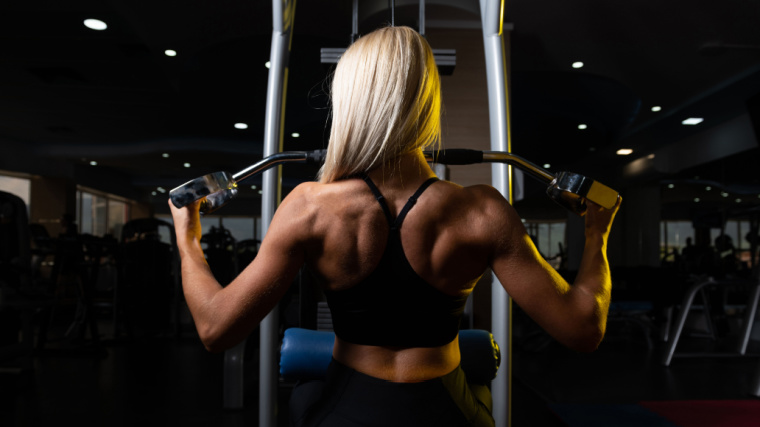 Credit: Jasminko Ibrakovic / Shutterstock
Credit: Jasminko Ibrakovic / Shutterstock
Even if you’re not doing a split where pulling has its own day, make sure you’re not neglecting the pull side of your programming equation. Stronger pulls will keep your muscles and your strength balanced so that you don’t become all chest and no lats — not a great position to lift from. Here, we’ll lay out the best pull moves you can do (and how to program them).
Editor’s Note: The content on BarBend is meant to be informative in nature, but it should not be taken as medical advice. When starting a new training regimen and/or diet, it is always a good idea to consult a trusted medical professional. We are not a medical resource. The opinions and articles on this site are not intended for use as diagnosis, prevention, and/or treatment of health problems. They are not substitutes for consulting a qualified medical professional.
Best Pull Exercises
[*]Deadlift
[*]Pull-Up
[*]Chin-Up
[*]Bent-Over Row
[*]Lat Pulldown
[*]Dumbbell Pullover
[*]Single-Arm Dumbbell Row
[*]Seated Cable Row
[*]Face Pull
[*]Renegade Row
[*]Biceps Curl
1. Deadlift
Lower body exercises may not be your first thought when it comes to pull exercises, but the deadlift is supreme. It’s a hip-dominant, full-body compound exercise. You’ll lock in your core and upper body while you “pull” from your hips and push the floor away.
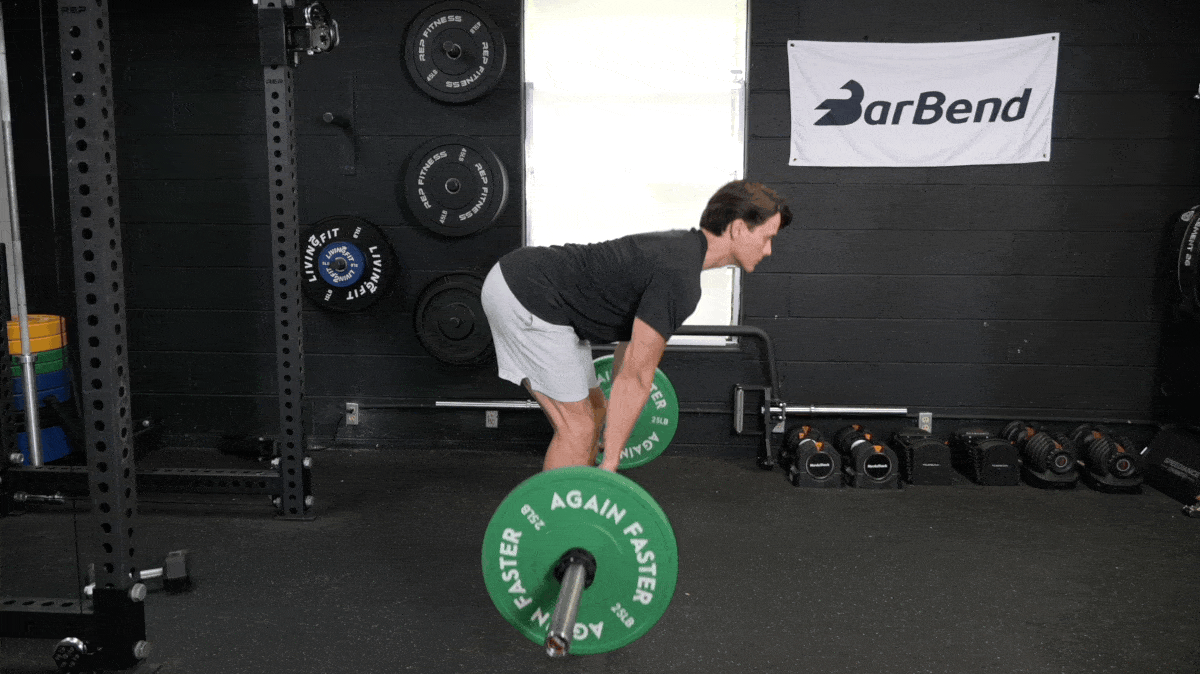
If you want to forge strength across your whole body, the deadlift is supreme. Deadlifts work your hamstrings, glutes, lower back, and entire posterior chain. Your core and grip will get smoked too. Get ready to work.
How to Do It:
[*]Stand tall with your feet about hip-width apart. Step up to the loaded barbell with the center of the bar over your midfoot.
[*]Inhale as you hinge your hips back. Keep your core engaged and chin gently tucked. Bend your knees until you reach the barbell. Grab with an overhand grip and hands slightly closer than shoulder-width apart, depending on limb length. Depress your shoulder blades to engage your lats and keep your chest up.
[*]Exhale to push through your feet, drive through your hips, and stand up with tension. Keep the bar close to you so it slightly touches your shins. Tuck your hips and squeeze your glutes at the top.
[*]Brace your core, keep your back straight, and lower back down with tension. Keep the bar close. Repeat for your desired number of reps.
Coach’s Tip: Different stances may work better for different lifters. Try a wider stance to accommodate your hips better if you’ve got longer legs.
Sets and Reps: Try four to five sets of five deadlifts for strength gains. For building muscle, start with three sets of eight reps.
Equipment Needed: Barbell, weight plates, collars
Modification: Beginners can start by learning a bodyweight hip hinge and progress to kettlebells, dumbbells, and barbells. Use a yoga block to “raise the floor” when you’re just learning this move. Deadlift a kettlebell off a yoga block to learn the movement before having to hinge all the way to the ground.
2. Pull-Up
The pull-up is a classic bodyweight exercise and the ultimate upper-body, vertical pulling movement. All you need is a pull-up bar and maybe a resistance band to do it.
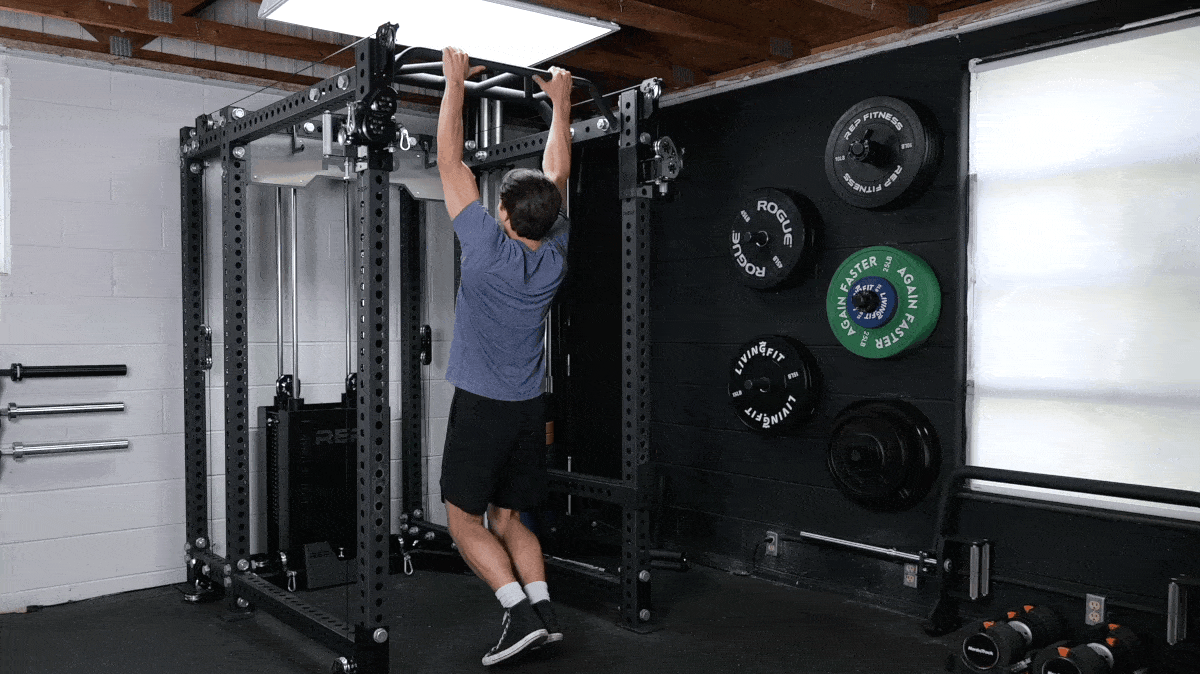
Pull-ups work all your pulling muscles. Your smaller stabilizer muscles, like posterior deltoids (rear delts) and erector spinae, assist your larger muscle groups, like your latissimus dorsi (lats) to achieve the feat of pulling yourself up.
How to Do It:
[*]Grab the bar with an overhand grip. Place your hands shoulder-width apart or go a little wider. Use a box or step to help you reach.
[*]Inhale and brace your core. Depress your shoulder blades to engage your lats.
[*]Exhale and pull yourself up so your chin passes the bar.
[*]Inhale and lower down with control until your arms are entirely straight to achieve the full range of motion. Repeat.
Coach’s Tip: Keep your core tight and back straight. Squeeze your glutes to create full body tension.
Sets and Reps: Try four sets of four to six reps for increasing strength. For muscle growth, try three sets of 10 to 12 reps.
Equipment Needed: Pull-up bar, pull-up assist bands (optional)
Modification: If you’re new to pull-ups, start learning to hang from the pull-up bar to build your grip strength. Don’t have the pull until you’re confident with your dead-hanging skill. Then, add some scapular pull-ups where you elevate your torso without bending your arms. Then, you can add a sturdy resistance band or try an assisted pull-up machine at your gym.
3. Chin-Up
If you’re still working up to doing a pull-up, try out a chin-up in the meantime. Chin-ups get some flack for being “easier” than a traditional pull-up, but they’ll still majorly build your vertical pulling strength.
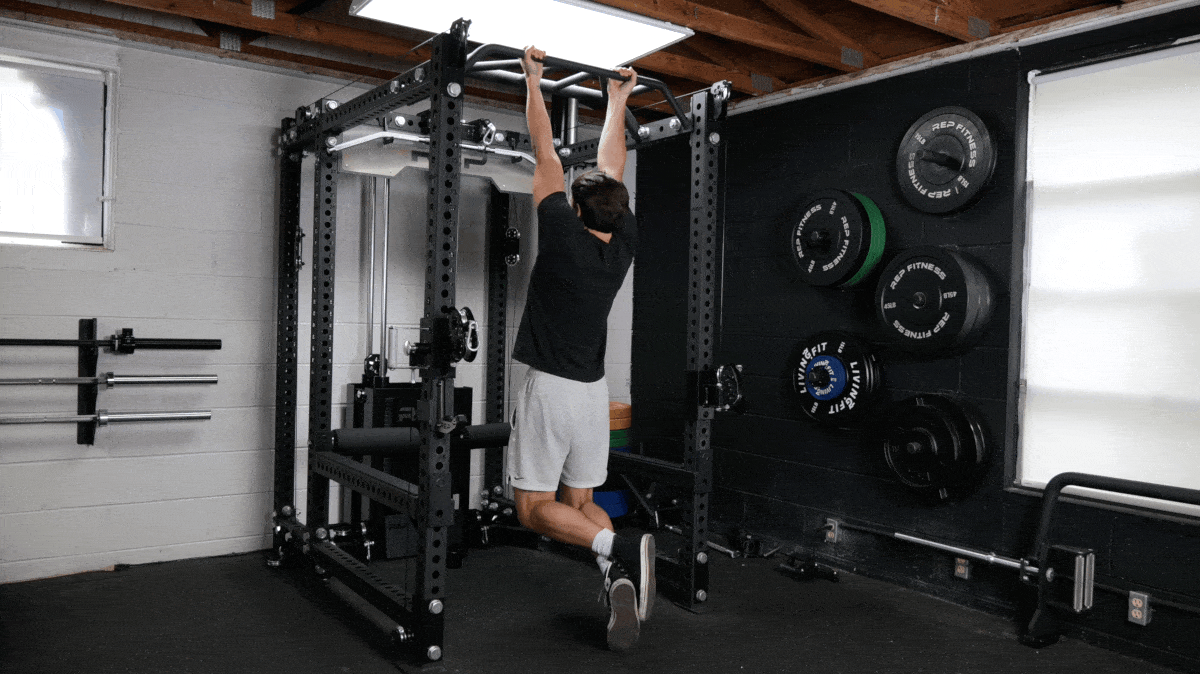
You use an underhand grip in chin-ups, so your biceps work slightly more than your upper back muscles.
How to Do It:
[*]Grab the bar with an underhand grip, palms facing your body. Keep your hands shoulder-width apart or closer, depending on your limb length.
[*]Inhale to brace your core. Depress your shoulder blades to engage your lats.
[*]Exhale to pull yourself up. Squeeze your upper back and biceps at the top.
[*]Inhale and lower down slowly until your arms fully extend. Repeat.
Coach’s Tip: Beginners can try eccentric chin-ups. Focus only on lowering down slowly, feeling the stretch in your biceps. Use a step-up platform or plyo box to get back up to the top.
Sets and Reps: Try four sets of five to six reps for strength gains. For muscle hypertrophy, do three sets of 10 to 12.
Equipment Needed: Pull-up bar, pull-up assist bands (optional)
Modification: Use a pull-up assist band, a strong resistance band, or even a pull-up assistance machine (if you have access to one) to support your body weight during this move.
4. Bent-Over Row
The bent-over row is a powerful, full-body horizontal pulling movement. It works your mid and upper-back muscles, including your lats, rear delts, rhomboids, and trapezius. At the same time, you engage your lower body and core to maintain stability.
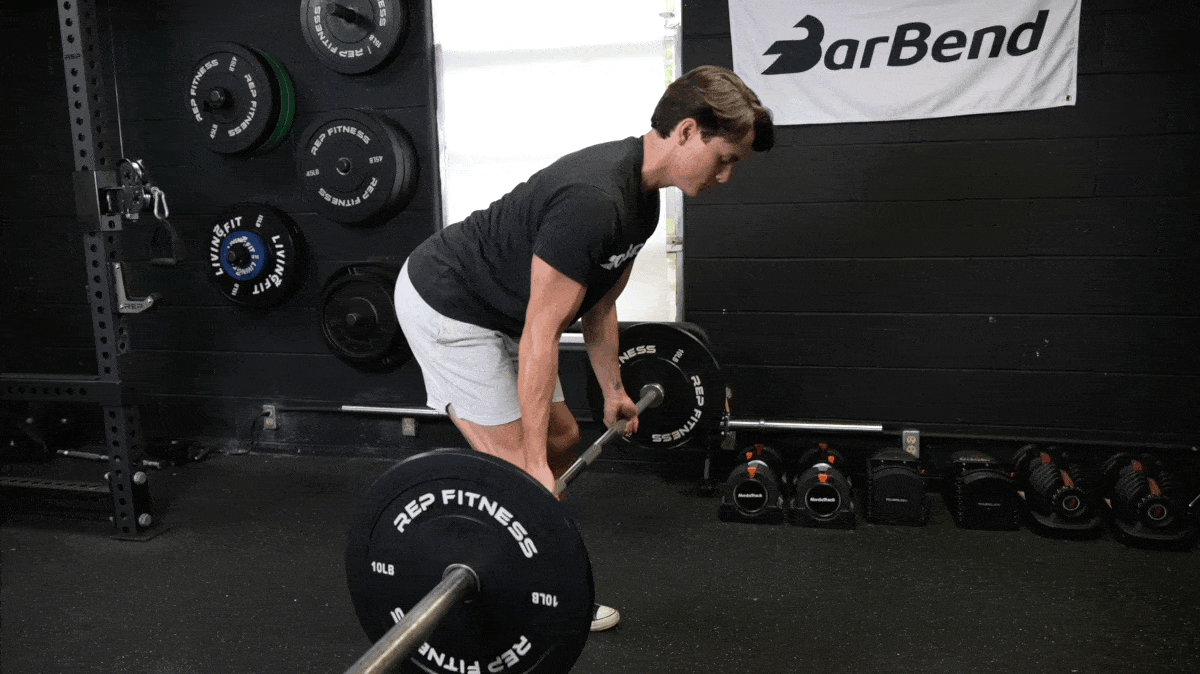
Beginners can start with kettlebells or dumbbells, while advanced lifters and bodybuilders can try out the barbell row. Doing a bent-over row with a barbell gives you room to lift heavier and increase strength and muscle mass in your back and upper body muscles. You’ll get an extra core workout as you engage your abs to keep your back straight.
How to Do It:
[*]Stand upright with your feet shoulder-width apart. Hold the bar with an overhand grip.
[*]Hinge your hips back. Keep a slight bend in your knees, chest up, back straight, and core engaged. Depress and slightly externally rotate your shoulders.
[*]Inhale, then exhale to row the barbell. Pull your elbows to the ceiling as you pull the barbell to your lower chest. Squeeze your shoulder blades together but maintain a neutral spine.
[*]Lower back down to the starting position with control. Repeat.
Coach’s Tip: Keep your abs engaged to maintain a neutral spine and protect your lower back.
Sets and Reps: For strength gains, try five sets of four to six reps. For muscle growth, try three to four sets of 10 reps.
Equipment Needed: Barbell, weight plates, barbell collars
Modification: Perform a chest-supported variation — like a supported T-bar row or a seal row — to help make sure you maintain your form. This will take pressure off your back and hips to maintain position.
5. Lat Pulldown
The lat pulldown is a great vertical pulling exercise that can help you build your strength to get your first pull-up. You perform it seated, making it more accessible for some folks.
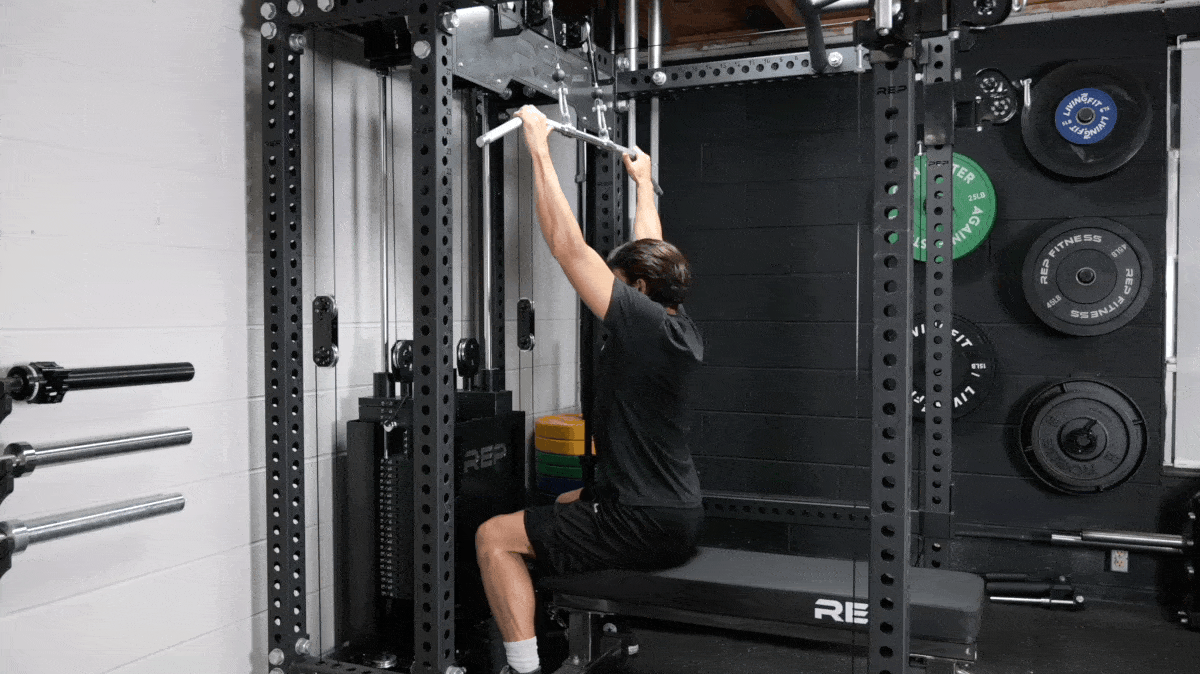
Lat pulldowns work your latissimus dorsi and your upper back muscles like your rear delts, rhomboids, and trapezius.
How to Do It:
[*]Sit up tall in the seat. Grab your bar with an overhand grip. Place your hands shoulder-width apart. Engage your abs, press your feet into the floor, and keep your back straight. Retract your head.
[*]Inhale, then exhale to pull the bar down to your chest. Imagine pulling your elbows towards the floor to keep your forearms and wrists straight.
[*]Depress your shoulders at the bottom to feel your lats. Slightly retract your shoulder blades, but keep your spine neutral.
[*]Inhale to slowly return the bar to the starting position. Exhale to pull down again and continue.
Coach’s Tip: Don’t let the bar pull you back up; fight against the resistance for more time under tension.
Sets and Reps: For increasing strength, try four sets of six to eight reps. For muscle growth, do three to four sets of 10 to 12.
Equipment Needed: Lat pulldown machine OR cable machine; straight bar
Modification: You can play with different grips on the bar or use handle attachments to make this a unilateral exercise. You can also use a handle that allows for a neutral grip to keep your shoulders in a more natural position.
6. Dumbbell Pullover
The dumbbell pullover works your upper back, chest, and triceps at the same time. It’s performed lying on a bench so you can focus on your upper body. The dumbbell pullover takes your shoulders through flexion and extension, so you’ll get some mobility work at the same time.
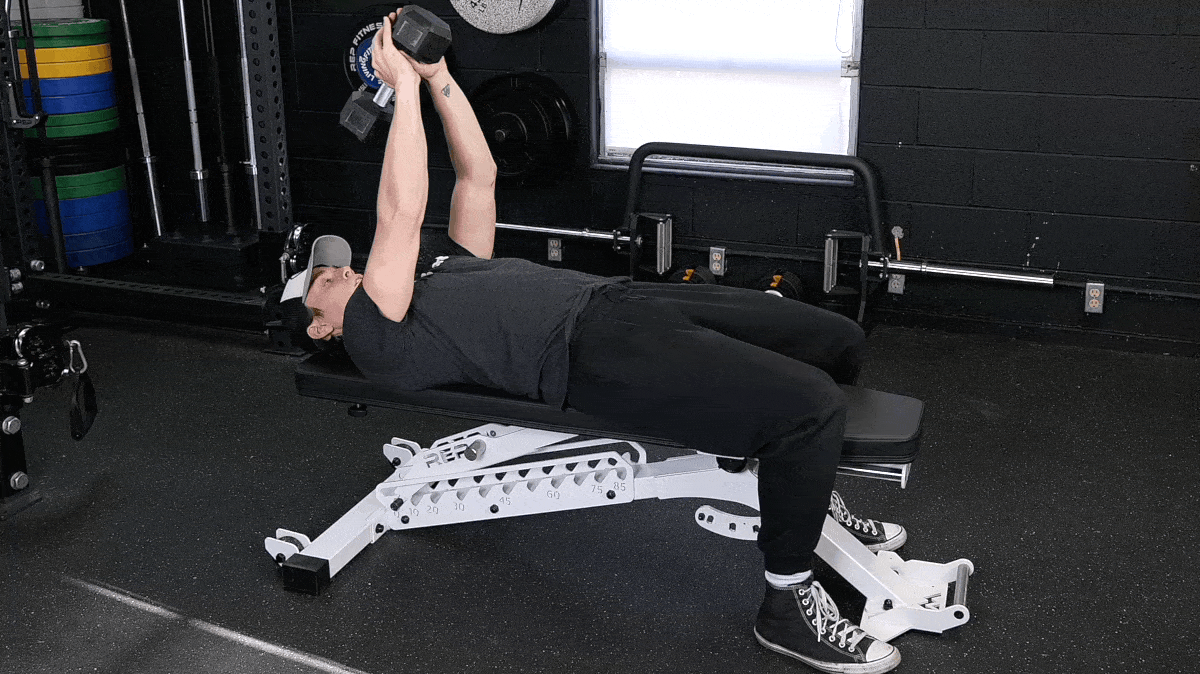
The dumbbell pullover puts your shoulders through a large range of motion, but you can start with your current range and build up over time.
How to Do It:
[*]Grab your dumbbell and lay on your back on the bench. Press your feet into the floor, squeeze your glutes, and engage your abs to build tension.
[*]Hold one end of a dumbbell with both hands. Keep a slight bend in your elbows and press it up from your chest.
[*]Keep your body still. Inhale and lower your arms backward, keeping a slight bend in your elbows. Lower your arms until you feel a stretch in your chest, triceps, and lats.
[*]Exhale to return your arms to the starting position. Continue on.
Coach’s Tip: Maintain stability in your core to protect your spine and lower back. Don’t push past your range of motion; engage your muscles and feel the stretch however far you can.
Sets and Reps: For increasing strength, try four to five sets of six to eight reps. For hypertrophy, do three to four sets of 10 to 12 reps.
Equipment Needed: Weight bench, dumbbell
7. Single-Arm Dumbbell Row
The single-arm dumbbell row is a compound horizontal pulling movement that builds unilateral strength in your upper back muscles — especially your lats and rhomboids.
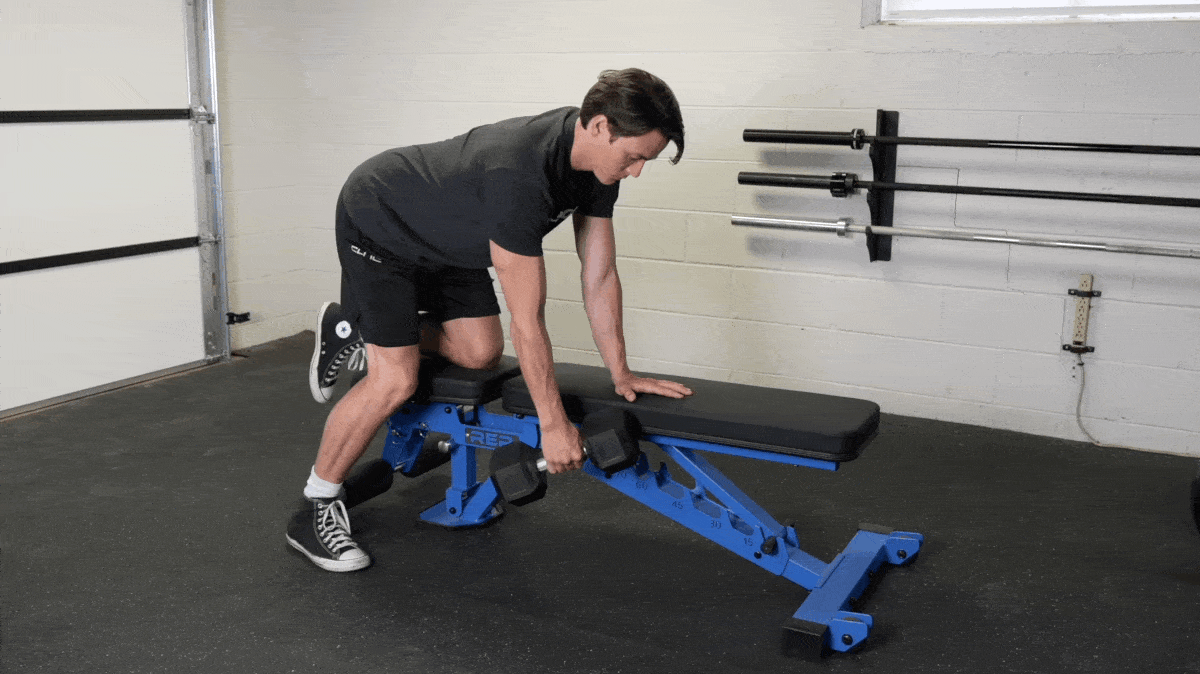
Unilateral training refers to working one side at a time and may help even out muscle, strength, mobility, and stability imbalances. Doing a unilateral pull exercise is an excellent complement to your bilateral pulling movements.
How to Do It:
[*]Stand at a bench and hold your dumbbell in one hand with an overhand grip. Hinge your hips back. Slightly bend your knees and hinge until your torso is parallel to the floor. Keep your back straight and place the other hand on the bench.
[*]Engage your abs, squeeze your glutes, and push your feet into the floor to create tension. Depress your shoulders to feel your lats.
[*]Inhale, then exhale to pull your elbow to the ceiling to row your dumbbell. Keep your arm close to your body. Feel your shoulder blade retract, and your rhomboids engage at the top.
[*]Inhale to slowly lower your arm back to the starting position. Exhale to repeat and continue.
Coach’s Tip: Don’t let your shoulder round forward as you lower the weight. Keep your lats and rear delts engaged to keep your shoulder externally rotated.
Sets and Reps: Four building strength, try four to five sets of six reps on each side. For hypertrophy, do three to four sets of 10 reps per side.
Equipment Needed: Dumbbell, weight bench
Modifications: During the single-arm dumbbell row, you use a bench for support, so you may be able to go a bit heavier. Consider using wrist wraps to make sure your grip doesn’t fatigue before your back does.
8. Seated Cable Row
The seated cable row is a horizontal pull exercise using a cable machine for maximum tension. Cable machines provide a different resistance from free weights. As you fight against letting the cable pull you too quickly, you build more pulling strength and muscular endurance. Seated cable rows will build and strengthen your mid and upper back muscles, including your rhomboids, rear delts, and lats.
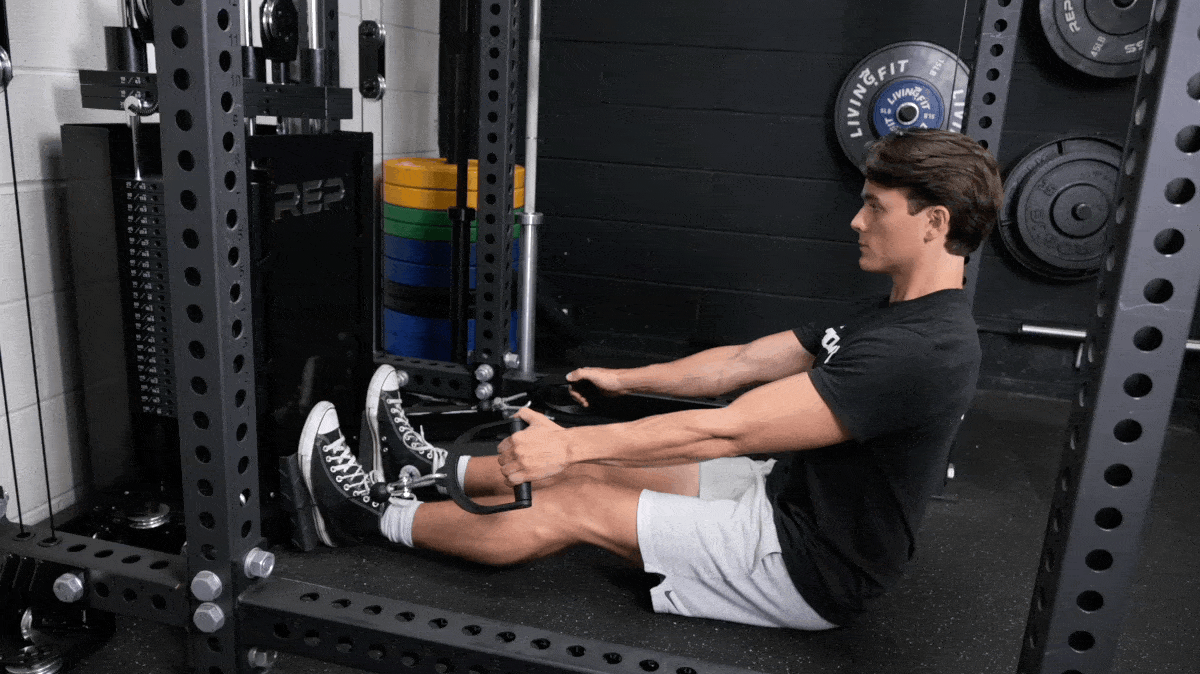
Since you’re sitting down and your feet are braced, you can row a little heavier and build up your back muscles’ strength and size. Seated exercises are also helpful for older adults or folks who can’t stand.
How to Do It:
[*]Attach your grip of choice. Sit up tall on the bench. Keep a slight bend in your knees.
[*]Grab your attachment with an overhand grip. Row it back until you sit tall with your abs engaged and elbows bent.
[*]Inhale to straighten your arms slowly, maintaining your tall posture and back straight.
[*]Exhale to row the handle to your chest. Squeeze your shoulder blades together without overextending your spine. Continue.
Coach’s Tip: Go slowly on the eccentric movement for more stretch and time under tension.
Sets and Reps: For strength gains, try four to five sets of six to eight reps. For muscle growth, do four sets of 10.
Equipment Needed: Cable machine, D-handle
Modification: You can do seated cable rows bilaterally or unilaterally with a single-arm cable row. Play with a narrow or wider grip to target different areas.
9. Face Pull
Face pulls focus on your upper back muscles to hit your trapezius and rear delts. They aim to strengthen the posterior deltoids and improve posture for people who sit hunched over at work.
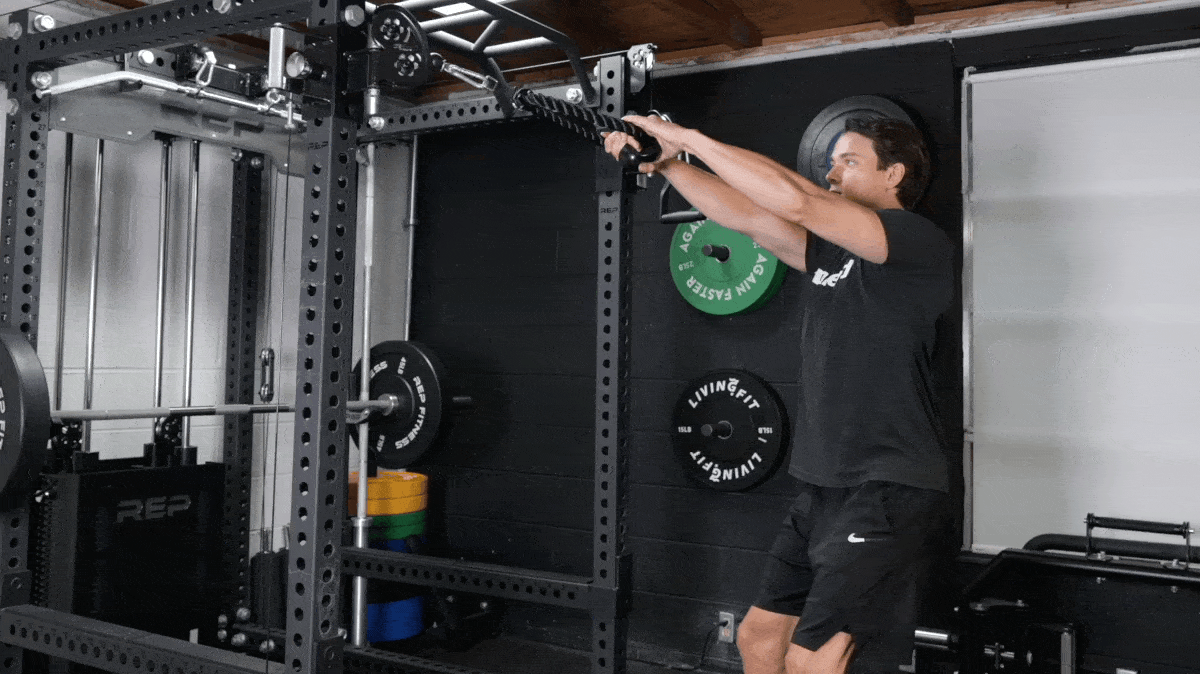
The rear delts are small and often neglected muscles, so bodybuilders will also benefit from this isolation exercise.
How to Do It:
[*]Attach the rope to a cable machine at eye level. Hold each end of the rope with an overhand grip, palms facing each other.
[*]Face the cable machine and take a few steps backward until your arms are straight and you feel the resistance. Stand with your feet shoulder-width apart and press them into the ground. Keep a slight bend in your knees, tuck your hips, and squeeze your glutes.
[*]Inhale to brace your core. Exhale as you pull the rope towards your face. Pull until each rope side is on either side of your face. Keep your elbows up. Squeeze your shoulder blades together.
[*]Inhale to slowly straighten your arms and return to the starting position. Exhale to pull again and continue.
Coach’s Tip: Resist getting pulled forward as you straighten your arms. Keep your abs engaged, back straight, and feet planted firmly.
Sets and Reps: Try four sets of eight to 10 reps for increasing strength. For building muscle mass, do three sets of 10 to 12 reps.
Equipment Needed: Cable machine, triceps rope attachment
Modification: You can also perform this move from a seated position. Simply adjust the anchor point accordingly.
10. Renegade Row
The renegade row is an advanced compound exercise that adds a dumbbell row to a plank. It strengthens and builds your arm and back muscles while majorly taxing your core strength and stability.
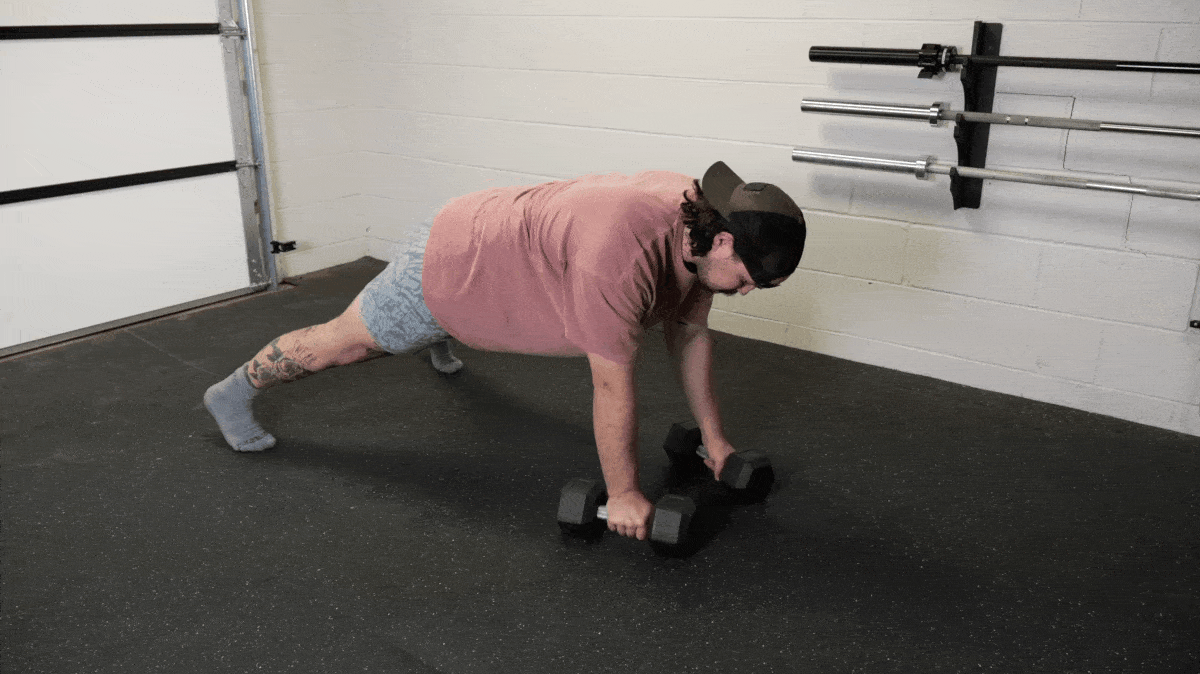
You’ll be keeping your core and hips steady while taxing your back muscles with slow pulls — it looks simple, but it’s quite the burner when you do it right.
How to Do It:
[*]Grab your dumbbells and place them shoulder-width apart. Get into a plank position with a dumbbell in each hand. Set your feet slightly wider than your hips. Squeeze your glutes and engage your abs to build tension.
[*]Inhale, then exhale and row one dumbbell up while keeping the other on the floor. Drive your elbow towards the ceiling and keep your arm close to your body.
[*]Inhale and lower the dumbbell back down slowly with control. Exhale to repeat the same arm or alternate sides.
[*]Maintain full-body tension throughout the rows.
Coach’s Tip: Resist movements through your shoulders, trunk, and hips.
Sets and Reps: Try four sets of six to eight rows per arm for strength gains. For building muscle, do three to four sets of ten rows per arm.
Equipment Needed: Dumbbells, yoga mat (optional)
Modification: Though the renegade row is challenging, it’s scalable for beginners. Start with doing a regular plank and rowing one arm without a dumbbell. You can also perform the renegade row with your knees down.
11. Biceps Curl
The simple and classic biceps curl is renowned as one of the best biceps exercises for a reason. If you want to fill out your T-shirt, biceps curls will help build that rounded peak.
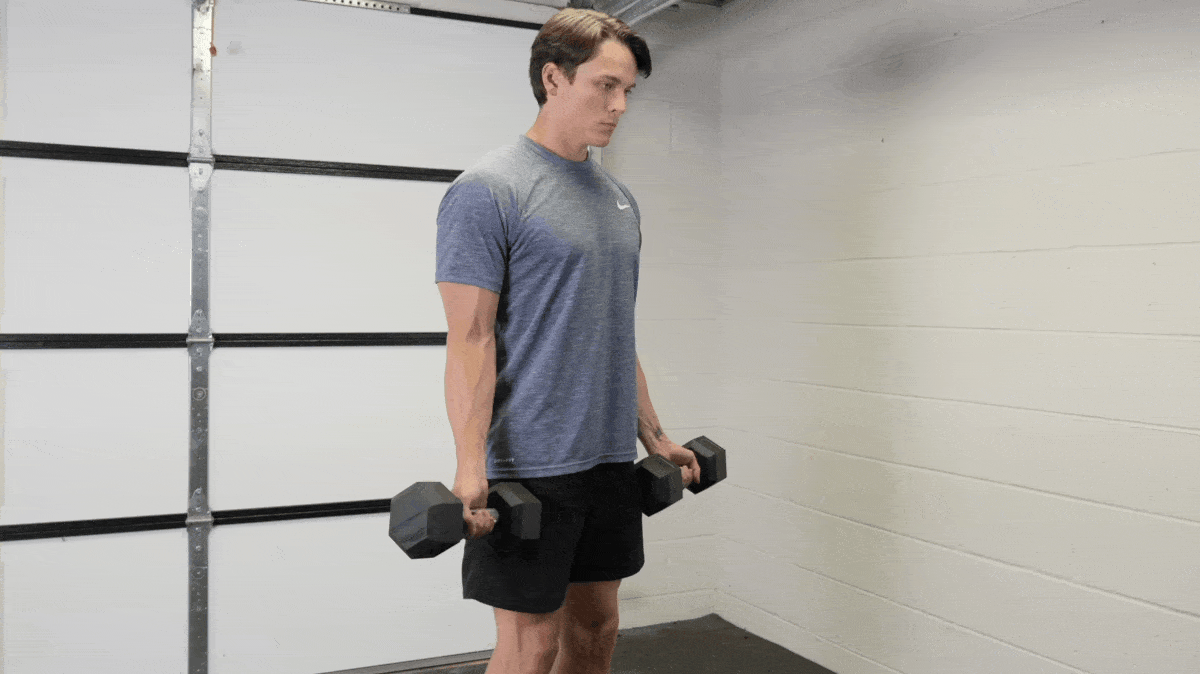
They can also increase pull strength for compound exercises like the bent-over row, pull-up and chin-up. Doing them unilaterally can help even out aesthetic or strength imbalances.
How to Do It:
[*]Stand upright, holding your weight with your palms facing the ceiling. Push your feet into the floor, squeeze your glutes, and engage your abs to create full-body tension.
[*]Inhale to brace your core, then exhale and curl the weight toward your shoulders. Squeeze your biceps at the top.
[*]Inhale to lower down and slowly straighten your arms. Feel the stretch in your biceps at the bottom of your range of motion.
[*]Exhale to curl again, and continue. Maintain tension, keep your core engaged, and avoid using momentum to curl.
Coach’s Tip: Keep your wrists neutral throughout the movement, and don’t let the weight pull them into extension.
Sets and Reps: Try four sets of six to eight curls for strength gains. For building muscle, do three to four sets of 10 to 12 reps.
Equipment Needed: Dumbbells
Modification: You can perform them unilaterally or bilaterally and use dumbbells, kettlebells, or progress to the barbell curl. You can also perform incline dumbbell curls or spider curls to lock in your upper body and place maximum emphasis on your biceps.
Pull Exercises Warm-Up
Before your pull-day workout, you’ll want to do a proper dynamic warm-up. A dynamic warm-up typically includes light cardio activity, dynamic stretching, mobility work, and some movements specific to what you’ll be training.
Here’s a sample warm-up to try that focuses on your pulling muscles.
If you don’t have a rowing machine, use an air bike or elliptical — alternatively, jump rope for three sets of 30 seconds.
[Read More: How to Perform the Perfect Weighted Pull-Up]
Do small circles for the first set, medium for the second set, and large circles for the last set.
Use an empty bar to ramp up for moves like deadlifts or bent-over rows. For dumbbell exercises like single-arm rows and biceps curls, use lighter dumbbells to warm up for that move specifically. With cable machines, you’ll also use a lighter weight to warm up.
How to Train Pull Exercises
Ready to add more pull exercises to your workout routine? You can (and should) incorporate them into your regular strength training program. They will help you reach any fitness goal of muscle or strength gain while promoting balance and helping to develop your posterior chain.
Pull Exercise Selection
When selecting pull exercises, compound exercises like deadlifts, bent-over rows, and pull-ups will get you the most bang for your buck. Isolation exercises like biceps curls and face pulls can also build your pulling strength but in more isolated muscles and areas.
https://www.youtube.com/watch?v=oqDpaZkfV0oVideo can’t be loaded because JavaScript is disabled: CHIN UPS vs. PULL UPS — The Difference, Muscles Worked, and Benefits (https://www.youtube.com/watch?v=oqDpaZkfV0o)
[Read More: The One-Month-Long Pull-up Training Program for Beginners]
Add in unilateral exercises like the single-arm dumbbell row to even out any strength or muscle imbalances. Seated cable machine exercises like the lat pulldown and cable row are great if you’re recovering from a lower-body injury and want to maintain upper-body strength.
Pull Exercise Sets and Reps
Depending on your fitness goal, you’ll want to manipulate your sets and reps to lift your desired volume.
You’ll be able to go heavier with fewer reps on exercises that use more muscle groups, like deadlifts and bent-over rows. For exercises that use smaller muscles like face pulls, focus on maintaining proper form at a moderate weight for a moderate number of reps.
Read More: The Ultimate Push-Pull-Legs Workout Split for Every Experience Level]
Pull Training Tips
Here are our top tips for finding a good balance, hitting all your pulling muscles, and progressing.
Balance Push-Pull in Your Workout Routine
The bench press, overhead press, and push-ups are great exercises but don’t make the mistake of overemphasizing them. Because those moves focus on “mirror muscles” — the ones you can easily see when assessing your figure in the mirror — people often overtrain them.
[Read More: 4 Benefits of Jumping Pull-Ups]
Balance out your pushing movements with pulling exercises to bring essential balance to your body, strength, and training. And don’t worry — stronger lats does, indeed, support a stronger bench press.
Include Vertical and Horizontal Pulling Movements
Our list of the best pull exercises includes vertical and horizontal pulling movements — because you’ll want to incorporate a solid mix of different types of pulls.
Vertical pulling exercises involve pulling the weight up and down. You pull toward your trunk in horizontal pulling movements. And pulling from different angles helps target smaller muscles in specific regions of your back.
[Read More: The Best Pull-Up Variations for All Experience Levels]
Use Progressive Overload
No one wants to put in all that work in the gym only to have their gains tall. Use the principles of progressive overload to help ensure that you keep getting better, whether you are trying to increase strength or build muscle mass.
Progressive overload refers to making your workouts more challenging by changing one variable at a time throughout your training program.
[Read More: Banded Pull-Ups: Exercise Demo, Muscles Worked, and Benefits]
Adding more volume by increasing reps or weight is one method. But you won’t want to keep adding weight indefinitely for some exercises that work smaller muscles. You can change the exercise angle, vary unilateral and bilateral lifts, play with your time under tension, or switch up your equipment from resistance bands, cable machines, barbells, dumbbells and kettlebells.
Benefits of Pull Exercises
Now that you know how to train pull exercises, here’s why and how they can help you build a balanced physique.
May Correct Muscle Imbalances
If you currently push more than you pull, research says you’re not alone. A study on 180 active young adults found they had more strength in push-ups than pull-ups. Researchers theorize having this muscle and strength imbalance could hinder performance and increase the risk of injury. (1)
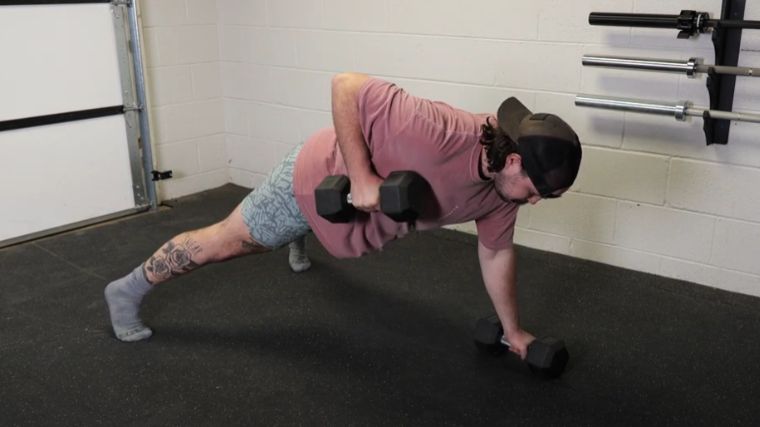
[Read More: The Ultimate Beginner Pull-Up Guide (4-Weeks to Your First Rep!)]
Since push-ups and pull-ups use different shoulder girdle muscles, doing mostly push exercises overdevelops the front of the shoulder while neglecting the back. Researchers recommend an equal balance of upper body pushing and pulling movements to correct imbalances, improve performance, and prevent injury. (1)
Builds and Strengthens Back Muscles
Bodybuilders will want to do plenty of pull exercises to build their back muscles for aesthetics. A strong back also helps protect your spine, improves posture, and may reduce back pain caused by weakness.
[Read More: Push/Pull Workouts Can Take Your Training Up a Notch]
One study found that sitting with rounded or hunched shoulders when you work long hours in an office can lead to shoulder and back pain. Letting your shoulders round forward leads to poor posture, but sitting up straight is difficult if your back muscles are weak. Strengthening those muscles with posture exercises and pull exercises can help improve your seated posture. (2)
Compound Exercises Save Time
If you don’t have much time to train, choosing compound exercises like the deadlift, pull-up, and bent-over row is a good strategy. These exercises hit multiple upper and lower body muscle groups and include horizontal and vertical pulling patterns.
Research shows that...
Click here to view the article.
The post The 11 Best Pull Exercises to Forge a Bigger, Stronger Back appeared first on BarBend.
You know what to do on leg day. And push days are known to bring on the bench press and overhead press. But pull day is looming in your push-pull-legs workout split, and you’re unsure which moves to include. Don’t worry — we’ve got the best pull exercises right here.

Even if you’re not doing a split where pulling has its own day, make sure you’re not neglecting the pull side of your programming equation. Stronger pulls will keep your muscles and your strength balanced so that you don’t become all chest and no lats — not a great position to lift from. Here, we’ll lay out the best pull moves you can do (and how to program them).
Editor’s Note: The content on BarBend is meant to be informative in nature, but it should not be taken as medical advice. When starting a new training regimen and/or diet, it is always a good idea to consult a trusted medical professional. We are not a medical resource. The opinions and articles on this site are not intended for use as diagnosis, prevention, and/or treatment of health problems. They are not substitutes for consulting a qualified medical professional.
Best Pull Exercises
[*]Deadlift
[*]Pull-Up
[*]Chin-Up
[*]Bent-Over Row
[*]Lat Pulldown
[*]Dumbbell Pullover
[*]Single-Arm Dumbbell Row
[*]Seated Cable Row
[*]Face Pull
[*]Renegade Row
[*]Biceps Curl
1. Deadlift
Lower body exercises may not be your first thought when it comes to pull exercises, but the deadlift is supreme. It’s a hip-dominant, full-body compound exercise. You’ll lock in your core and upper body while you “pull” from your hips and push the floor away.

If you want to forge strength across your whole body, the deadlift is supreme. Deadlifts work your hamstrings, glutes, lower back, and entire posterior chain. Your core and grip will get smoked too. Get ready to work.
How to Do It:
[*]Stand tall with your feet about hip-width apart. Step up to the loaded barbell with the center of the bar over your midfoot.
[*]Inhale as you hinge your hips back. Keep your core engaged and chin gently tucked. Bend your knees until you reach the barbell. Grab with an overhand grip and hands slightly closer than shoulder-width apart, depending on limb length. Depress your shoulder blades to engage your lats and keep your chest up.
[*]Exhale to push through your feet, drive through your hips, and stand up with tension. Keep the bar close to you so it slightly touches your shins. Tuck your hips and squeeze your glutes at the top.
[*]Brace your core, keep your back straight, and lower back down with tension. Keep the bar close. Repeat for your desired number of reps.
Coach’s Tip: Different stances may work better for different lifters. Try a wider stance to accommodate your hips better if you’ve got longer legs.
Sets and Reps: Try four to five sets of five deadlifts for strength gains. For building muscle, start with three sets of eight reps.
Equipment Needed: Barbell, weight plates, collars
Modification: Beginners can start by learning a bodyweight hip hinge and progress to kettlebells, dumbbells, and barbells. Use a yoga block to “raise the floor” when you’re just learning this move. Deadlift a kettlebell off a yoga block to learn the movement before having to hinge all the way to the ground.
2. Pull-Up
The pull-up is a classic bodyweight exercise and the ultimate upper-body, vertical pulling movement. All you need is a pull-up bar and maybe a resistance band to do it.

Pull-ups work all your pulling muscles. Your smaller stabilizer muscles, like posterior deltoids (rear delts) and erector spinae, assist your larger muscle groups, like your latissimus dorsi (lats) to achieve the feat of pulling yourself up.
How to Do It:
[*]Grab the bar with an overhand grip. Place your hands shoulder-width apart or go a little wider. Use a box or step to help you reach.
[*]Inhale and brace your core. Depress your shoulder blades to engage your lats.
[*]Exhale and pull yourself up so your chin passes the bar.
[*]Inhale and lower down with control until your arms are entirely straight to achieve the full range of motion. Repeat.
Coach’s Tip: Keep your core tight and back straight. Squeeze your glutes to create full body tension.
Sets and Reps: Try four sets of four to six reps for increasing strength. For muscle growth, try three sets of 10 to 12 reps.
Equipment Needed: Pull-up bar, pull-up assist bands (optional)
Modification: If you’re new to pull-ups, start learning to hang from the pull-up bar to build your grip strength. Don’t have the pull until you’re confident with your dead-hanging skill. Then, add some scapular pull-ups where you elevate your torso without bending your arms. Then, you can add a sturdy resistance band or try an assisted pull-up machine at your gym.
3. Chin-Up
If you’re still working up to doing a pull-up, try out a chin-up in the meantime. Chin-ups get some flack for being “easier” than a traditional pull-up, but they’ll still majorly build your vertical pulling strength.

You use an underhand grip in chin-ups, so your biceps work slightly more than your upper back muscles.
How to Do It:
[*]Grab the bar with an underhand grip, palms facing your body. Keep your hands shoulder-width apart or closer, depending on your limb length.
[*]Inhale to brace your core. Depress your shoulder blades to engage your lats.
[*]Exhale to pull yourself up. Squeeze your upper back and biceps at the top.
[*]Inhale and lower down slowly until your arms fully extend. Repeat.
Coach’s Tip: Beginners can try eccentric chin-ups. Focus only on lowering down slowly, feeling the stretch in your biceps. Use a step-up platform or plyo box to get back up to the top.
Sets and Reps: Try four sets of five to six reps for strength gains. For muscle hypertrophy, do three sets of 10 to 12.
Equipment Needed: Pull-up bar, pull-up assist bands (optional)
Modification: Use a pull-up assist band, a strong resistance band, or even a pull-up assistance machine (if you have access to one) to support your body weight during this move.
4. Bent-Over Row
The bent-over row is a powerful, full-body horizontal pulling movement. It works your mid and upper-back muscles, including your lats, rear delts, rhomboids, and trapezius. At the same time, you engage your lower body and core to maintain stability.

Beginners can start with kettlebells or dumbbells, while advanced lifters and bodybuilders can try out the barbell row. Doing a bent-over row with a barbell gives you room to lift heavier and increase strength and muscle mass in your back and upper body muscles. You’ll get an extra core workout as you engage your abs to keep your back straight.
How to Do It:
[*]Stand upright with your feet shoulder-width apart. Hold the bar with an overhand grip.
[*]Hinge your hips back. Keep a slight bend in your knees, chest up, back straight, and core engaged. Depress and slightly externally rotate your shoulders.
[*]Inhale, then exhale to row the barbell. Pull your elbows to the ceiling as you pull the barbell to your lower chest. Squeeze your shoulder blades together but maintain a neutral spine.
[*]Lower back down to the starting position with control. Repeat.
Coach’s Tip: Keep your abs engaged to maintain a neutral spine and protect your lower back.
Sets and Reps: For strength gains, try five sets of four to six reps. For muscle growth, try three to four sets of 10 reps.
Equipment Needed: Barbell, weight plates, barbell collars
Modification: Perform a chest-supported variation — like a supported T-bar row or a seal row — to help make sure you maintain your form. This will take pressure off your back and hips to maintain position.
5. Lat Pulldown
The lat pulldown is a great vertical pulling exercise that can help you build your strength to get your first pull-up. You perform it seated, making it more accessible for some folks.

Lat pulldowns work your latissimus dorsi and your upper back muscles like your rear delts, rhomboids, and trapezius.
How to Do It:
[*]Sit up tall in the seat. Grab your bar with an overhand grip. Place your hands shoulder-width apart. Engage your abs, press your feet into the floor, and keep your back straight. Retract your head.
[*]Inhale, then exhale to pull the bar down to your chest. Imagine pulling your elbows towards the floor to keep your forearms and wrists straight.
[*]Depress your shoulders at the bottom to feel your lats. Slightly retract your shoulder blades, but keep your spine neutral.
[*]Inhale to slowly return the bar to the starting position. Exhale to pull down again and continue.
Coach’s Tip: Don’t let the bar pull you back up; fight against the resistance for more time under tension.
Sets and Reps: For increasing strength, try four sets of six to eight reps. For muscle growth, do three to four sets of 10 to 12.
Equipment Needed: Lat pulldown machine OR cable machine; straight bar
Modification: You can play with different grips on the bar or use handle attachments to make this a unilateral exercise. You can also use a handle that allows for a neutral grip to keep your shoulders in a more natural position.
6. Dumbbell Pullover
The dumbbell pullover works your upper back, chest, and triceps at the same time. It’s performed lying on a bench so you can focus on your upper body. The dumbbell pullover takes your shoulders through flexion and extension, so you’ll get some mobility work at the same time.

The dumbbell pullover puts your shoulders through a large range of motion, but you can start with your current range and build up over time.
How to Do It:
[*]Grab your dumbbell and lay on your back on the bench. Press your feet into the floor, squeeze your glutes, and engage your abs to build tension.
[*]Hold one end of a dumbbell with both hands. Keep a slight bend in your elbows and press it up from your chest.
[*]Keep your body still. Inhale and lower your arms backward, keeping a slight bend in your elbows. Lower your arms until you feel a stretch in your chest, triceps, and lats.
[*]Exhale to return your arms to the starting position. Continue on.
Coach’s Tip: Maintain stability in your core to protect your spine and lower back. Don’t push past your range of motion; engage your muscles and feel the stretch however far you can.
Sets and Reps: For increasing strength, try four to five sets of six to eight reps. For hypertrophy, do three to four sets of 10 to 12 reps.
Equipment Needed: Weight bench, dumbbell
7. Single-Arm Dumbbell Row
The single-arm dumbbell row is a compound horizontal pulling movement that builds unilateral strength in your upper back muscles — especially your lats and rhomboids.

Unilateral training refers to working one side at a time and may help even out muscle, strength, mobility, and stability imbalances. Doing a unilateral pull exercise is an excellent complement to your bilateral pulling movements.
How to Do It:
[*]Stand at a bench and hold your dumbbell in one hand with an overhand grip. Hinge your hips back. Slightly bend your knees and hinge until your torso is parallel to the floor. Keep your back straight and place the other hand on the bench.
[*]Engage your abs, squeeze your glutes, and push your feet into the floor to create tension. Depress your shoulders to feel your lats.
[*]Inhale, then exhale to pull your elbow to the ceiling to row your dumbbell. Keep your arm close to your body. Feel your shoulder blade retract, and your rhomboids engage at the top.
[*]Inhale to slowly lower your arm back to the starting position. Exhale to repeat and continue.
Coach’s Tip: Don’t let your shoulder round forward as you lower the weight. Keep your lats and rear delts engaged to keep your shoulder externally rotated.
Sets and Reps: Four building strength, try four to five sets of six reps on each side. For hypertrophy, do three to four sets of 10 reps per side.
Equipment Needed: Dumbbell, weight bench
Modifications: During the single-arm dumbbell row, you use a bench for support, so you may be able to go a bit heavier. Consider using wrist wraps to make sure your grip doesn’t fatigue before your back does.
8. Seated Cable Row
The seated cable row is a horizontal pull exercise using a cable machine for maximum tension. Cable machines provide a different resistance from free weights. As you fight against letting the cable pull you too quickly, you build more pulling strength and muscular endurance. Seated cable rows will build and strengthen your mid and upper back muscles, including your rhomboids, rear delts, and lats.

Since you’re sitting down and your feet are braced, you can row a little heavier and build up your back muscles’ strength and size. Seated exercises are also helpful for older adults or folks who can’t stand.
How to Do It:
[*]Attach your grip of choice. Sit up tall on the bench. Keep a slight bend in your knees.
[*]Grab your attachment with an overhand grip. Row it back until you sit tall with your abs engaged and elbows bent.
[*]Inhale to straighten your arms slowly, maintaining your tall posture and back straight.
[*]Exhale to row the handle to your chest. Squeeze your shoulder blades together without overextending your spine. Continue.
Coach’s Tip: Go slowly on the eccentric movement for more stretch and time under tension.
Sets and Reps: For strength gains, try four to five sets of six to eight reps. For muscle growth, do four sets of 10.
Equipment Needed: Cable machine, D-handle
Modification: You can do seated cable rows bilaterally or unilaterally with a single-arm cable row. Play with a narrow or wider grip to target different areas.
9. Face Pull
Face pulls focus on your upper back muscles to hit your trapezius and rear delts. They aim to strengthen the posterior deltoids and improve posture for people who sit hunched over at work.

The rear delts are small and often neglected muscles, so bodybuilders will also benefit from this isolation exercise.
How to Do It:
[*]Attach the rope to a cable machine at eye level. Hold each end of the rope with an overhand grip, palms facing each other.
[*]Face the cable machine and take a few steps backward until your arms are straight and you feel the resistance. Stand with your feet shoulder-width apart and press them into the ground. Keep a slight bend in your knees, tuck your hips, and squeeze your glutes.
[*]Inhale to brace your core. Exhale as you pull the rope towards your face. Pull until each rope side is on either side of your face. Keep your elbows up. Squeeze your shoulder blades together.
[*]Inhale to slowly straighten your arms and return to the starting position. Exhale to pull again and continue.
Coach’s Tip: Resist getting pulled forward as you straighten your arms. Keep your abs engaged, back straight, and feet planted firmly.
Sets and Reps: Try four sets of eight to 10 reps for increasing strength. For building muscle mass, do three sets of 10 to 12 reps.
Equipment Needed: Cable machine, triceps rope attachment
Modification: You can also perform this move from a seated position. Simply adjust the anchor point accordingly.
10. Renegade Row
The renegade row is an advanced compound exercise that adds a dumbbell row to a plank. It strengthens and builds your arm and back muscles while majorly taxing your core strength and stability.

You’ll be keeping your core and hips steady while taxing your back muscles with slow pulls — it looks simple, but it’s quite the burner when you do it right.
How to Do It:
[*]Grab your dumbbells and place them shoulder-width apart. Get into a plank position with a dumbbell in each hand. Set your feet slightly wider than your hips. Squeeze your glutes and engage your abs to build tension.
[*]Inhale, then exhale and row one dumbbell up while keeping the other on the floor. Drive your elbow towards the ceiling and keep your arm close to your body.
[*]Inhale and lower the dumbbell back down slowly with control. Exhale to repeat the same arm or alternate sides.
[*]Maintain full-body tension throughout the rows.
Coach’s Tip: Resist movements through your shoulders, trunk, and hips.
Sets and Reps: Try four sets of six to eight rows per arm for strength gains. For building muscle, do three to four sets of ten rows per arm.
Equipment Needed: Dumbbells, yoga mat (optional)
Modification: Though the renegade row is challenging, it’s scalable for beginners. Start with doing a regular plank and rowing one arm without a dumbbell. You can also perform the renegade row with your knees down.
11. Biceps Curl
The simple and classic biceps curl is renowned as one of the best biceps exercises for a reason. If you want to fill out your T-shirt, biceps curls will help build that rounded peak.

They can also increase pull strength for compound exercises like the bent-over row, pull-up and chin-up. Doing them unilaterally can help even out aesthetic or strength imbalances.
How to Do It:
[*]Stand upright, holding your weight with your palms facing the ceiling. Push your feet into the floor, squeeze your glutes, and engage your abs to create full-body tension.
[*]Inhale to brace your core, then exhale and curl the weight toward your shoulders. Squeeze your biceps at the top.
[*]Inhale to lower down and slowly straighten your arms. Feel the stretch in your biceps at the bottom of your range of motion.
[*]Exhale to curl again, and continue. Maintain tension, keep your core engaged, and avoid using momentum to curl.
Coach’s Tip: Keep your wrists neutral throughout the movement, and don’t let the weight pull them into extension.
Sets and Reps: Try four sets of six to eight curls for strength gains. For building muscle, do three to four sets of 10 to 12 reps.
Equipment Needed: Dumbbells
Modification: You can perform them unilaterally or bilaterally and use dumbbells, kettlebells, or progress to the barbell curl. You can also perform incline dumbbell curls or spider curls to lock in your upper body and place maximum emphasis on your biceps.
Pull Exercises Warm-Up
Before your pull-day workout, you’ll want to do a proper dynamic warm-up. A dynamic warm-up typically includes light cardio activity, dynamic stretching, mobility work, and some movements specific to what you’ll be training.
Here’s a sample warm-up to try that focuses on your pulling muscles.
- Rowing Machine: 1 x 3 minutes
- Arm Circle: 3 x 30 seconds forward and 30 seconds backward
- Horizontal Arm Swing: 1 x 30 seconds
- Vertical Arm Swing: 1 x 30 seconds
- Band Pull-Apart: 2 x 15
- TRX Row: 2 x 10
- Ramp-Up Set: 2 x 3-8, exercise specific
If you don’t have a rowing machine, use an air bike or elliptical — alternatively, jump rope for three sets of 30 seconds.
[Read More: How to Perform the Perfect Weighted Pull-Up]
Do small circles for the first set, medium for the second set, and large circles for the last set.
Use an empty bar to ramp up for moves like deadlifts or bent-over rows. For dumbbell exercises like single-arm rows and biceps curls, use lighter dumbbells to warm up for that move specifically. With cable machines, you’ll also use a lighter weight to warm up.
How to Train Pull Exercises
Ready to add more pull exercises to your workout routine? You can (and should) incorporate them into your regular strength training program. They will help you reach any fitness goal of muscle or strength gain while promoting balance and helping to develop your posterior chain.
Pull Exercise Selection
When selecting pull exercises, compound exercises like deadlifts, bent-over rows, and pull-ups will get you the most bang for your buck. Isolation exercises like biceps curls and face pulls can also build your pulling strength but in more isolated muscles and areas.
https://www.youtube.com/watch?v=oqDpaZkfV0oVideo can’t be loaded because JavaScript is disabled: CHIN UPS vs. PULL UPS — The Difference, Muscles Worked, and Benefits (https://www.youtube.com/watch?v=oqDpaZkfV0o)
[Read More: The One-Month-Long Pull-up Training Program for Beginners]
Add in unilateral exercises like the single-arm dumbbell row to even out any strength or muscle imbalances. Seated cable machine exercises like the lat pulldown and cable row are great if you’re recovering from a lower-body injury and want to maintain upper-body strength.
Pull Exercise Sets and Reps
Depending on your fitness goal, you’ll want to manipulate your sets and reps to lift your desired volume.
- For Strength: You want to lift heavier weights for fewer reps to increase your strength. Try three to five sets of three to six reps at a challenging weight and high effort level.
- For Muscle Growth: While you can build muscle at a variety of rep ranges, three to four sets of eight to 12 reps is a good place to start. Push toward failure in each set.
- For Unilateral Strength: If you’re focusing on unilateral gains, you’ll be doing more total reps but an even amount on each arm. Try three sets of eight to 10 reps.
You’ll be able to go heavier with fewer reps on exercises that use more muscle groups, like deadlifts and bent-over rows. For exercises that use smaller muscles like face pulls, focus on maintaining proper form at a moderate weight for a moderate number of reps.
Read More: The Ultimate Push-Pull-Legs Workout Split for Every Experience Level]
Pull Training Tips
Here are our top tips for finding a good balance, hitting all your pulling muscles, and progressing.
Balance Push-Pull in Your Workout Routine
The bench press, overhead press, and push-ups are great exercises but don’t make the mistake of overemphasizing them. Because those moves focus on “mirror muscles” — the ones you can easily see when assessing your figure in the mirror — people often overtrain them.
[Read More: 4 Benefits of Jumping Pull-Ups]
Balance out your pushing movements with pulling exercises to bring essential balance to your body, strength, and training. And don’t worry — stronger lats does, indeed, support a stronger bench press.
Include Vertical and Horizontal Pulling Movements
Our list of the best pull exercises includes vertical and horizontal pulling movements — because you’ll want to incorporate a solid mix of different types of pulls.
Vertical pulling exercises involve pulling the weight up and down. You pull toward your trunk in horizontal pulling movements. And pulling from different angles helps target smaller muscles in specific regions of your back.
[Read More: The Best Pull-Up Variations for All Experience Levels]
Use Progressive Overload
No one wants to put in all that work in the gym only to have their gains tall. Use the principles of progressive overload to help ensure that you keep getting better, whether you are trying to increase strength or build muscle mass.
Progressive overload refers to making your workouts more challenging by changing one variable at a time throughout your training program.
[Read More: Banded Pull-Ups: Exercise Demo, Muscles Worked, and Benefits]
Adding more volume by increasing reps or weight is one method. But you won’t want to keep adding weight indefinitely for some exercises that work smaller muscles. You can change the exercise angle, vary unilateral and bilateral lifts, play with your time under tension, or switch up your equipment from resistance bands, cable machines, barbells, dumbbells and kettlebells.
Benefits of Pull Exercises
Now that you know how to train pull exercises, here’s why and how they can help you build a balanced physique.
May Correct Muscle Imbalances
If you currently push more than you pull, research says you’re not alone. A study on 180 active young adults found they had more strength in push-ups than pull-ups. Researchers theorize having this muscle and strength imbalance could hinder performance and increase the risk of injury. (1)

[Read More: The Ultimate Beginner Pull-Up Guide (4-Weeks to Your First Rep!)]
Since push-ups and pull-ups use different shoulder girdle muscles, doing mostly push exercises overdevelops the front of the shoulder while neglecting the back. Researchers recommend an equal balance of upper body pushing and pulling movements to correct imbalances, improve performance, and prevent injury. (1)
Builds and Strengthens Back Muscles
Bodybuilders will want to do plenty of pull exercises to build their back muscles for aesthetics. A strong back also helps protect your spine, improves posture, and may reduce back pain caused by weakness.
[Read More: Push/Pull Workouts Can Take Your Training Up a Notch]
One study found that sitting with rounded or hunched shoulders when you work long hours in an office can lead to shoulder and back pain. Letting your shoulders round forward leads to poor posture, but sitting up straight is difficult if your back muscles are weak. Strengthening those muscles with posture exercises and pull exercises can help improve your seated posture. (2)
Compound Exercises Save Time
If you don’t have much time to train, choosing compound exercises like the deadlift, pull-up, and bent-over row is a good strategy. These exercises hit multiple upper and lower body muscle groups and include horizontal and vertical pulling patterns.
Research shows that...
Click here to view the article.

